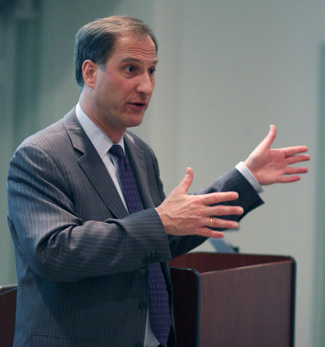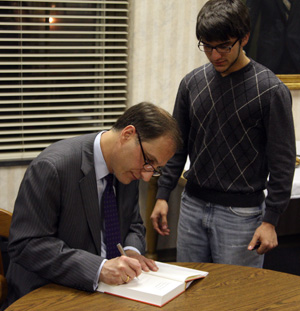An analysis of the subprime mortgage crisis was the topic Rogge lecturer Charles Calomiris. Calomiris aimed to "look at what’s old and what’s new [in the crisis] and look from a perspective both of the origins of the crisis, its causes, and also the way it has proceeded."
 Calomiris, who had a significant background in economic history, defined the financial crisis in order to place it into a historical context. "We have to ask, ‘What is this type of crisis that we are talking about?’" Calamiris asked, "because it’s not the internet bubble kind of crisis, it’s not a crisis that has to do with the stock market declining, although that’s happened. The kind of crisis I’m interested in comparing this to looking back over the last couple hundred years is a crisis that has to do with real estate market and bank credit. And there are lots of such crises in United States history."
Calomiris, who had a significant background in economic history, defined the financial crisis in order to place it into a historical context. "We have to ask, ‘What is this type of crisis that we are talking about?’" Calamiris asked, "because it’s not the internet bubble kind of crisis, it’s not a crisis that has to do with the stock market declining, although that’s happened. The kind of crisis I’m interested in comparing this to looking back over the last couple hundred years is a crisis that has to do with real estate market and bank credit. And there are lots of such crises in United States history."
Calomiris cited all these crises had two main ingredients: loose monetary policy that help to worsen credit conditions, and government subsidation from taking risk in borrowing against real estate.
Calomiris, who is a professor at Columbia University, focused on Fannie Mae and Freddie Mac as two of the mortgage firms responsible for 1.6 trillion of the 3 trillion dollars worth of outstanding subprime credit. The firms, Calomiris said, used deceit to meet the government quota on affordable housing while still trying to please investors. "They were meeting much more than their [government-mandated] requirement on affordable housing, but at the same time, they wanted their investors to believe that their portfolios were good. So what did they do? They said, ‘We’re managing to lend to minority and low-income borrowers who are not really subprime.’ And guess what? They were lying."
To make matters worse, the government, Calomiris said, created several laws that encouraged subprime loans and subprime mortgage-backed securities.
To justify their ill-advised business practices, Calomiris asserted, the firms simply used a flawed model. In 2001, similar to today, the housing market also had an especially high rate of foreclosures. "Having [subprime]foreclosures at that high level meant that people who were building risk models in 2003 and 2004 of the subprime market could say that they had seen a recession stress test of the subprime market."
 However, Calomiris added there was a unique twist to this recession that caused only minimal losses. "Unlike every other recession in US history, the recession of 2001 was one in which housing prices were still going up a lot. That was an unusual episode. Anyone who knew what was going on in this market knew that the ratings were inflated, knew that the models were based on completely faulty, forward-looking assumptions based on an idiosyncratic one-time event, the recession of 2001. No one could have believed these models. So why did they use them? I say plausible deniability."
However, Calomiris added there was a unique twist to this recession that caused only minimal losses. "Unlike every other recession in US history, the recession of 2001 was one in which housing prices were still going up a lot. That was an unusual episode. Anyone who knew what was going on in this market knew that the ratings were inflated, knew that the models were based on completely faulty, forward-looking assumptions based on an idiosyncratic one-time event, the recession of 2001. No one could have believed these models. So why did they use them? I say plausible deniability."
The financial crisis has also seen a few unique features that are different from many of the crises that preceded it. One big difference has been the banks’ ability to raise capital. That, Calomiris said, is a result of deregulation that diversified bank operations internationally and across states. He also added that this crisis has featured especially aggressive government intervention.
Calomiris also discussed what the Federal Reserve is doing to help. "The Fed has done amazing things it’s never done before," Calomiris said. "I view the breadth of the new activities as appropriate. It’s really been sort of a head-spinning, dizzying kind of array of new instruments being developed almost monthly."
Ultimately, however, Calomiris said there needs to be a price floor, or minimum price, on these "toxic" financial bank assets in order to resurrect the financial situation. However, he justified any potential risk by explaining that the taxpayers own any of this potential risk.
"We already own the risk. Fanny [Mae] and Freddy [Mac] are in conservatorship, you own them, and they have half of the risk. You also already own AIG, you also already own a lot of CitiBank. You own the bad outcome. Why not own it and recognize that you own it, and by doing that change out of these liquidity crises impacted asset prices to prices that will turn this thing around," Calomiris said.
The Rogge Lecture is an annual event named after Benjamin Rogge, a former economics professor at Wabash College.
Photos by Alex Moseman '11